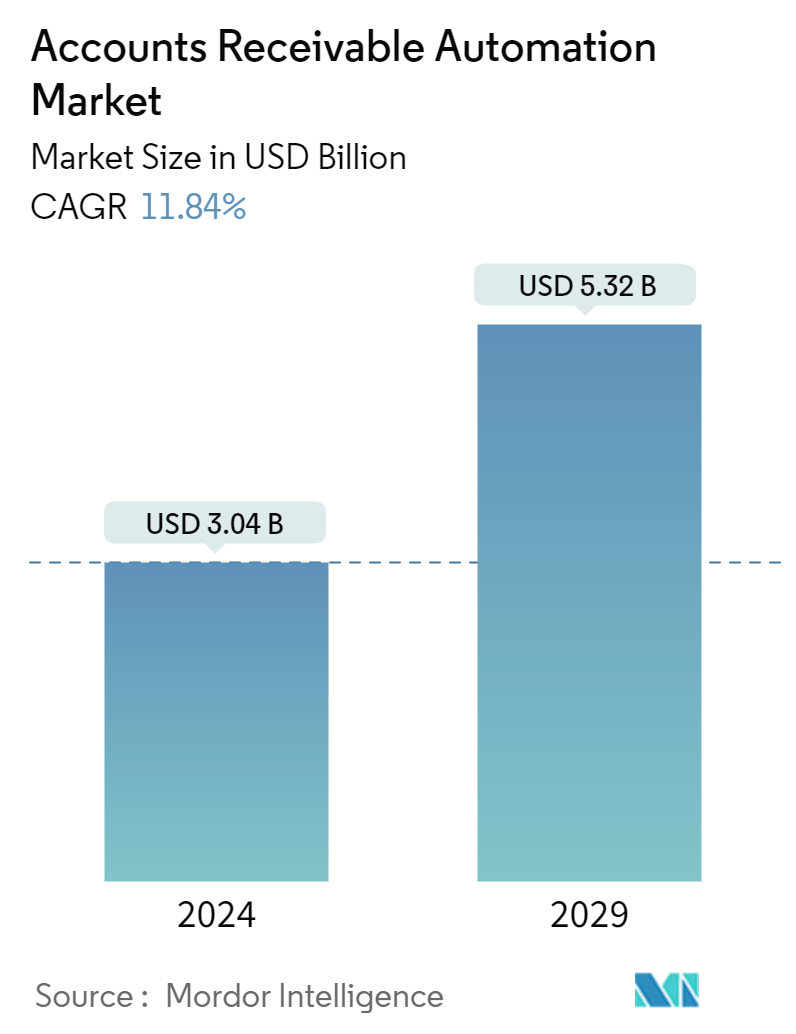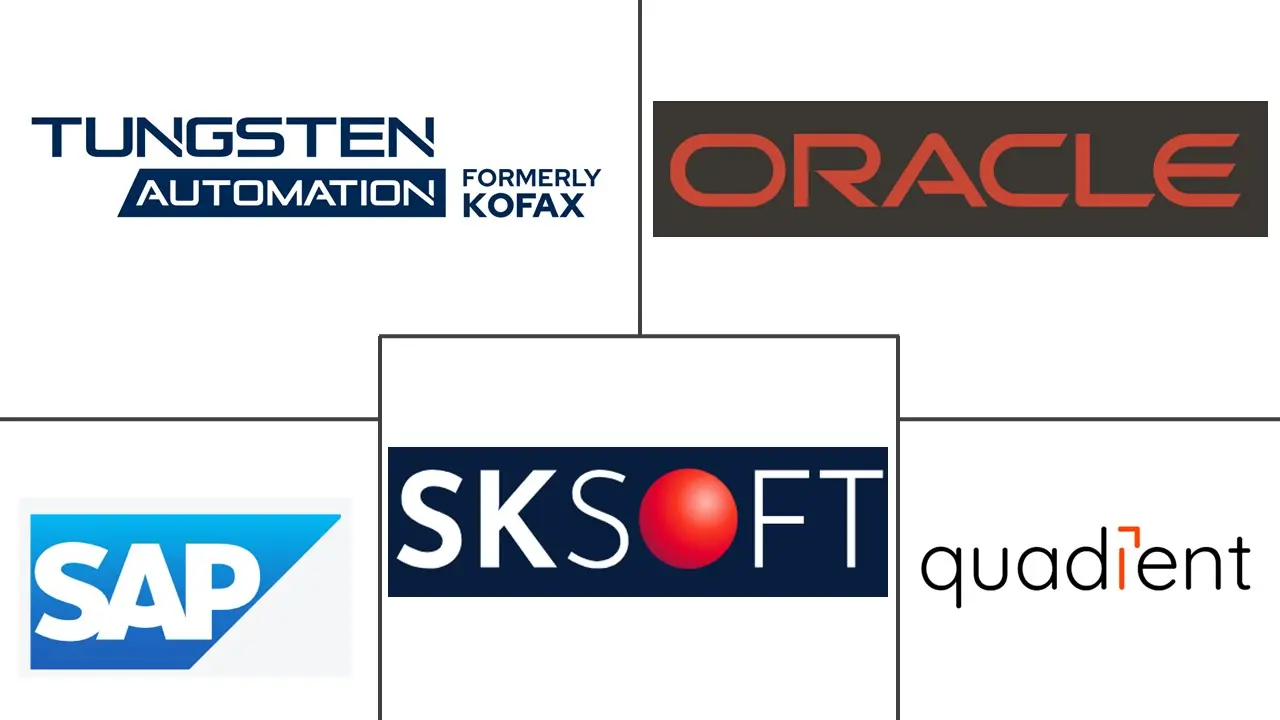Market Size of Accounts Receivable Automation Industry

| Study Period | 2019 - 2029 |
| Market Size (2024) | USD 3.04 Billion |
| Market Size (2029) | USD 5.32 Billion |
| CAGR (2024 - 2029) | 11.84 % |
| Fastest Growing Market | Asia-Pacific |
| Largest Market | North America |
Major Players
*Disclaimer: Major Players sorted in no particular order |
AR Automation Market Analysis
The Accounts Receivable Automation Market size is estimated at USD 3.04 billion in 2024, and is expected to reach USD 5.32 billion by 2029, growing at a CAGR of 11.84% during the forecast period (2024-2029).
- Efficiency Gains Drive Adoption of AR Automation: The Accounts Receivable Automation Market is witnessing rapid growth, primarily driven by the need for improved business efficiency, optimized cash flow, and cost reduction. Companies utilizing accounts receivable automation software have reported notable enhancements in both processing speed and team efficiency. For instance, a study by PYMNTS indicated that 87% of firms employing AR automation solutions can process invoices faster, while 79% experience increased team productivity. The cost advantage is also clear, as automated invoicing systems can generate electronic invoices for under USD 2, compared to up to USD 25 for paper invoices.
- Reduced DSO: AR automation has been shown to decrease Days Sales Outstanding (DSO) by as much as 30%, providing significant improvements in cash flow.
- Increased Processing Capacity: Automated systems can handle up to 19,000 invoices per month, compared to just 4,500 for manual processes.
- Quick Payback: 65% of companies report recouping their investment in AR workflow automation within 12 months, with this figure rising to 78% after 18 months.
- Cloud and AI Technologies Revolutionize AR Processes: The increasing adoption of cloud-based AR platforms and AI in accounts receivable is transforming the way businesses manage their accounts receivable functions. Cloud technology offers unmatched flexibility, scalability, and cost-efficiency, attracting businesses of all sizes. Cisco’s report predicts that 94% of all workloads will be processed in cloud data centers, with 75% of these workloads expected to be on Software-as-a-Service (SaaS) platforms by 2021.
- Cloud Adoption: 90% of companies have integrated some form of cloud service, which is crucial for digital payment processing in AR.
- AI Deployment: 34% of firms in the US, UK, and China are already using AI, demonstrating its growing role in automating AR functions.
- Speed and Accuracy: AI-powered payment reconciliation automation improves invoice processing speeds and accuracy, driving enhanced financial outcomes.
Market Dynamics and Future Outlook:
The market is seeing growing demand for accounts receivable management tools from both large corporations and SMEs. The need to reduce manual errors, ensure cash flow predictability, and improve customer experiences is pushing companies to adopt AR automation solutions. According to BlueSnap’s report, 93% of organizations face challenges with outdated AR processes, and 81% believe that late payments pose a risk to their business continuity.
- Delayed Payments Impact: On average, 27% of customers exceed their payment terms, leading to 30% of monthly revenue being tied up in accounts receivable.
- SME Challenges: SMEs face similar issues, with about 24% of monthly revenue held up in AR, highlighting the need for cash flow automation.
- Industry-Specific Growth: The healthcare sector is expected to experience a compound annual growth rate (CAGR) of 15.51% in AR automation adoption, underscoring the technology’s broad appeal.
Innovative Solutions and Market Players:
Key players in the market, such as HighRadius, Sage, and Esker, are innovating to provide financial automation technologies that streamline the entire order-to-cash cycle. These platforms not only automate invoice generation and payment matching but also integrate features such as accounts receivable analytics and predictive behavior models.
- Strategic Partnerships: HighRadius has teamed up with Sage to integrate RadiusOne A/R Suite with Sage Intacct, modernizing cloud-based AR operations.
- Advanced Features: Esker’s Cash Application solution optimizes the matching of invoices with received payments, boosting efficiency in the reconciliation process.
- AI Integration: Wells Fargo has developed automated collections management tools that leverage AI and machine learning for capturing payment and remittance data more effectively.
AR Automation Industry Segmentation
Accounts receivable automation is the modernization of the accounts receivable processes via electronic systems, which helps in reducing repetitive and time-consuming tasks. Automation helps free up the time for accounts receivable teams to focus on higher-value work by optimizing their schedules and reducing task dependencies.
The accounts receivable automation market is segmented by component (solutions and services), by deployment mode (on-premise and cloud), by size of the organization (small and medium enterprises and large enterprises), by end-user industry (BFSI, IT and telecom, manufacturing, healthcare, and transportation and logistics, other end-user industries), and by geography (North America, Europe, Asia Pacific, Latin America and Middle East and Africa). The report offers market forecasts and size in value (USD) for all the above segments.
| By Component | |
| Solutions | |
| Services |
| By Deployment Mode | |
| On-premise | |
| Cloud |
| By Size of the Organization | |
| Small and Medium Enterprises | |
| Large Enterprises |
| By End-user Industry | |
| BFSI | |
| IT and Telecom | |
| Manufacturing | |
| Healthcare | |
| Transportation and Logistics | |
| Other End-user Industries |
| By Geography*** | |
| North America | |
| Europe | |
| Asia | |
| Australia and New Zealand | |
| Latin America | |
| Middle East and Africa |
Accounts Receivable Automation Market Size Summary
The Accounts Receivable Automation Market is poised for significant growth, driven by the increasing need for businesses to enhance efficiency and reduce costs. The automation of accounts receivable processes streamlines operations, offering benefits such as accurate credit decisions, improved liquidity management, and better sales reporting. Traditional paper-based invoicing methods present challenges, including high processing costs and inefficiencies, which automation addresses by digitizing invoices and reducing manual tasks. This shift not only cuts down on printing expenses but also enhances employee productivity, contributing to the global market's expansion. However, concerns over data security and the potential for cybercrimes pose challenges to the widespread adoption of digital solutions in this sector.
The market is experiencing a notable shift towards cloud-based solutions, fueled by the digital transformation initiatives of enterprises worldwide. Cloud accounting software offers flexibility and accessibility, allowing finance teams to manage processes remotely, which is a significant advantage over traditional on-premises systems. The increasing adoption of Software-as-a-Service (SaaS) models further propels the demand for cloud-based accounts receivable tools, as businesses seek to integrate these solutions with existing enterprise resource planning systems. The Asia-Pacific region is expected to witness robust growth due to the rising demand for automated and secure payable processes, with AI-driven solutions playing a crucial role in this expansion. The competitive landscape is moderately fragmented, with key players engaging in strategic acquisitions and partnerships to enhance their market presence and offer innovative solutions.
Accounts Receivable Automation Market Size - Table of Contents
-
1. MARKET INSIGHTS
-
1.1 Market Overview
-
1.2 Industry Attractiveness - Porter's Five Forces Analysis
-
1.2.1 Bargaining Power of Suppliers
-
1.2.2 Bargaining Power of Buyers
-
1.2.3 Threat of New Entrants
-
1.2.4 Threat of Substitutes
-
1.2.5 Intensity of Competitive Rivalry
-
-
1.3 Assessment of the Impact of COVID-19 on the Market
-
-
2. MARKET SEGMENTATION
-
2.1 By Component
-
2.1.1 Solutions
-
2.1.2 Services
-
-
2.2 By Deployment Mode
-
2.2.1 On-premise
-
2.2.2 Cloud
-
-
2.3 By Size of the Organization
-
2.3.1 Small and Medium Enterprises
-
2.3.2 Large Enterprises
-
-
2.4 By End-user Industry
-
2.4.1 BFSI
-
2.4.2 IT and Telecom
-
2.4.3 Manufacturing
-
2.4.4 Healthcare
-
2.4.5 Transportation and Logistics
-
2.4.6 Other End-user Industries
-
-
2.5 By Geography***
-
2.5.1 North America
-
2.5.2 Europe
-
2.5.3 Asia
-
2.5.4 Australia and New Zealand
-
2.5.5 Latin America
-
2.5.6 Middle East and Africa
-
-
Accounts Receivable Automation Market Size FAQs
How big is the Accounts Receivable Automation Market?
The Accounts Receivable Automation Market size is expected to reach USD 3.04 billion in 2024 and grow at a CAGR of 11.84% to reach USD 5.32 billion by 2029.
What is the current Accounts Receivable Automation Market size?
In 2024, the Accounts Receivable Automation Market size is expected to reach USD 3.04 billion.

